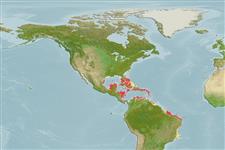>
Ophidiiformes (Cusk eels) >
Bythitidae (Livebearing brotulas)
Etymology: Stygnobrotula: Greek, stygnos, -ou = sad, hostile + Latin, brotula = little bud, shoot (Ref. 45335).
Environment: milieu / climate zone / depth range / distribution range
Οικολογία
Θαλασσινό(ά) Υφαλόφιλο(α). Tropical; - 21°S
Western Atlantic: Bahamas to Brazil (Ref. 40101).
Μέγεθος / Βάρος / Age
Maturity: Lm ? range ? - ? cm
Max length : 7.5 cm TL αρσενικό/απροσδιόριστο; (Ref. 7251)
A common species inhabiting shallow rocky ledges and reefs (Ref. 7251), found deep within the reef during the day (Ref. 9710). A live-bearing species (Ref. 5521).
Life cycle and mating behavior
Γεννητική Ωρίμανση | Αναπαραγωγή | Γεννοβολία | Αβγά | Γονιμότητα | Προνύμφες
Nielsen, J.G., D.M. Cohen, D.F. Markle and C.R. Robins, 1999. Ophidiiform fishes of the world (Order Ophidiiformes). An annotated and illustrated catalogue of pearlfishes, cusk-eels, brotulas and other ophidiiform fishes known to date. FAO Fish. Synop. 125(18):178p. Rome: FAO. (Ref. 34024)
IUCN Red List Status (Ref. 130435: Version 2024-2)
Threat to humans
Harmless
Human uses
αλιεία: χωρίς ενδιαφέρον
Εργαλεία
Special reports
Download XML
Διαδικτυακές πηγές
Estimates based on models
Preferred temperature (Ref.
123201): 25.9 - 28.2, mean 27.2 °C (based on 482 cells).
Phylogenetic diversity index (Ref.
82804): PD
50 = 1.0000 [Uniqueness, from 0.5 = low to 2.0 = high].
Bayesian length-weight: a=0.01122 (0.00514 - 0.02450), b=3.04 (2.87 - 3.21), in cm total length, based on all LWR estimates for this body shape (Ref.
93245).
Τροφικό Επίπεδο (Ref.
69278): 3.3 ±0.5 se; based on size and trophs of closest relatives
Ελαστικότητα (Ref.
120179): Χαμηλό, ελάχιστος χρόνος για διπλασιασμό πληθυσμού 4,5 - 14 έτη (Assuming Fec < 100).
Fishing Vulnerability (Ref.
59153): Low vulnerability (10 of 100).
Nutrients (Ref.
124155): Calcium = 139 [79, 281] mg/100g; Iron = 1.07 [0.62, 1.83] mg/100g; Protein = 17.1 [14.6, 19.7] %; Omega3 = 0.234 [0.124, 0.429] g/100g; Selenium = 41.1 [21.3, 81.8] μg/100g; VitaminA = 108 [35, 329] μg/100g; Zinc = 2.32 [1.57, 3.31] mg/100g (wet weight);
